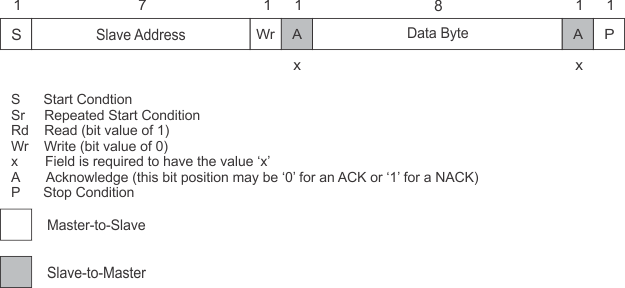SLVUC05A November 2020 – July 2022 TPS25750
- Read This First
- 1Introduction
-
2Unique Address Interface Register Detailed Descriptions
- 2.1 0x03 MODE Register
- 2.2 0x0D DEVICE_CAPABILITIES Register
- 2.3 0x14 - 0x19 INT_EVENT, INT_MASK, INT_CLEAR Registers
- 2.4 0x1A STATUS Register
- 2.5 0x26 POWER_PATH_STATUS Register
- 2.6 0x29 PORT_CONTROL Register
- 2.7 0x2D BOOT_STATUS Register
- 2.8 0x30 RX_SOURCE_CAPS Register
- 2.9 0x31 RX_SINK_CAPS Register
- 2.10 0x32 TX_SOURCE_CAPS Register
- 2.11 0x33 TX_SINK_CAPS Register
- 2.12 0x34 ACTIVE_CONTRACT_PDO Register
- 2.13 0x35 ACTIVE_CONTRACT_RDO Register
- 2.14 0x3F POWER_STATUS Register
- 2.15 0x40 PD_STATUS Register
- 2.16 GPIO Events
- 2.17 0x69 TYPEC_STATE Register
- 2.18 0x70 SLEEP_CONFIG Register
- 2.19 0x72 GPIO_STATUS Register
- 34CC Task Detailed Descriptions
- 4User Reference
- 5Revision History
1.2.1 Overview
The PD Controller provides one I2C slave. The I2Cs slave is meant to be connected to an Embedded Controller (EC).
The Host Interface defines how the registers are accessed from I2C slave port ands and all slave addresses. Slave Address #1 is selected by the customer using the ADCIN1 and ADCIN2 pins on the PD controller. See also Table 4-1 for more details about the slave addresses.
The Host Interface provides general status information to the master of these I2C interfaces about the PD Controller, ability to control the PD Controller, status of USB Type-C Port and communications to/from a connected device (Port Partner) and/or cable plug via USB PD messages. All Host Interface communication that uses the Unique I2C address is referred to as Unique Address Interface.
The PD Controller supports a register-based Unique Address Interface. Section 1.3.2 lists the Unique Address Interface registers and Chapter 2 provides detailed Unique Address Interface register descriptions.
The key to the protocol diagrams is in the SMBus Specification, version 2.0 and is repeated here in part in Figure 1-1.
 Figure 1-1 I2C Read/Write Protocol Key
Figure 1-1 I2C Read/Write Protocol Key